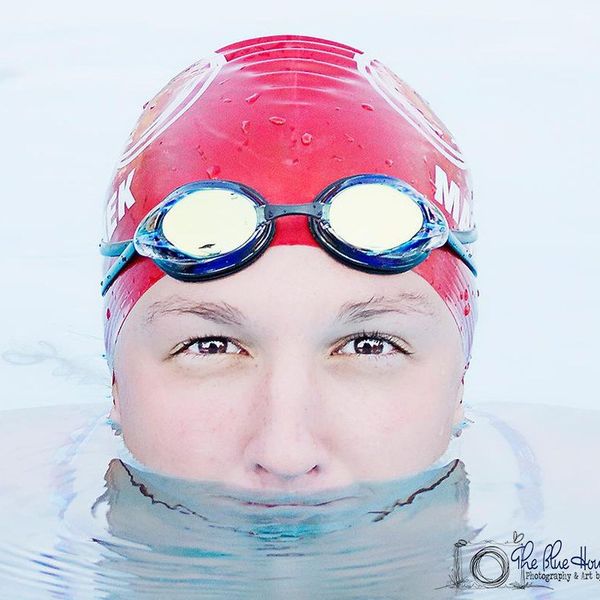Growing up I took swimming lessons at the local lake, taught by teens and young adults. My sister was both a lifeguard and a teacher at that beach and a few years later I was hired. Summer 2016 marks five years of teaching swimming lessons to kids ranging from 4 to 16 years old. Over these years, I have learned so much from my experiences, from my training and, most importantly, from the students. Although my job has its downfalls, I love getting up early and teaching young kids such an important skill. These are a few swim lessons that taught me life lessons.
1. Sometimes you just have to take a break from fighting and take a deep breath; maybe even float a while
In swim lessons, we teach the students that when they get too tired to continue swimming to lay on their backs and float for a while. It gives the swimmer a chance to rest and catch their breath. This also applies to life. When you get too tired to continue fighting, you don’t just give up and let yourself drown, you take a break and catch your breath. Then you continue your journey.
2. Everything is built off of the basics
In level one, we teach the students to put their faces in the water, blow bubbles and float. As the students move up in the levels, they learn their strokes and how to dive. But they cannot learn new things without remembering how to blow bubbles and float. This is why we go back to those basics before teaching new things. Sometimes in life you have to go back to the basics before you can move on.
3. You’re never too old to learn
Although the swim lessons that I both grew up taking and teach now are based on younger children, it is never too late to learn how to swim. It is a skill that is needed to survive in many different situations. It’s never too late to learn to swim, and it’s never too late to learn anything new. Always learning, everyday.
4. Take the leap, you’ll come back to the top
One of the things that we spend a lot of time working on with many kids is to get them to jump into deep water. We spend what seems like hours reassuring them that they will come back up and that it will be OK. We start by giving them help, allowing them to hold onto us to show them it will be OK. But eventually it comes to the point that they have to take the leap on their own. Life is the same way, you can test the waters with help, but it will be time to take the leap, and you will come back to the surface.
5. But always know what you are jumping into
One of the first safety lessons we go over (especially since I work at a dirty lake), is to look into the water before you jump. We look for people, rocks, sharp objects or anything else that could cause harm. We teach the students to know what they are jumping into, to know how deep it is, if they can touch or if they should dive. When you are ready to leap, make sure you know what you are going into.
6. Swim as a pair, just in case something goes wrong and you need a partner to give you a hand
Many facilities use the rule that each swimmer has a partner, and to make sure no one is missing, they will do partner checks. Personally I really like this idea and even in lessons we do a safety topic that tells the students to swim with a partner. This ensures that if anything goes wrong there, is always someone to give a hand, or to call for more help. This comes in handy in life also, to have your partner, that someone who makes sure you are still above water and when you are struggling they can give you a hand. You don’t always have to do it all alone.
7. Don’t go out over your head unless you are ready
Each year we have some brave swimmers who try to go in the deep water before they are ready. This sometimes even causes them to begin to drown. Everything comes in steps, and you cannot get ahead of yourself. Honor the fact that you need time to get ready for the next step, or you could end up in trouble.
8. It takes some work to keep your head above water
When the students get strong enough to go out over their heads, we teach them a very important skill: how to tread water -- how to keep their head above water when it is too deep. One thing the students learn right off is that it takes a lot of work. To pass certain levels, we have to test them on how long they can tread. Every year we have the students who ask why it has to be so hard and take so much work. It just shows that it isn’t always easy to stay alive, you have to put the work in. But always remember to give yourself a break. (See No. 1)
9. Don’t let your fears stop you
It is common to have students who are scared of the water and won't go out over their heads or dive head first. It is OK to have those fears. But what is not OK is to allow them to stop you from enjoying and experiencing life. You have to face your fears (safely of course) in order to grow. If that means to slowly do it with the help of others you can trust, so be it. But don’t allow your fears to keep you on shore instead of jumping in.
10. No matter what, always have fun
This is something I learned from some of my younger students. At the facility I work at we teach students starting at 4 years old, but I usually work with students 8 and older. Sometimes it seems to become more of a classroom, a chore to do. But this year I have had the pleasure of teaching some very insightful 8-year-olds. They have reminded me that swimming is supposed to be fun, it is supposed to be recreational and it is supposed to an experience. Life is the same way; you are always learning along the way, but it doesn’t mean it needs to be a chore.





















